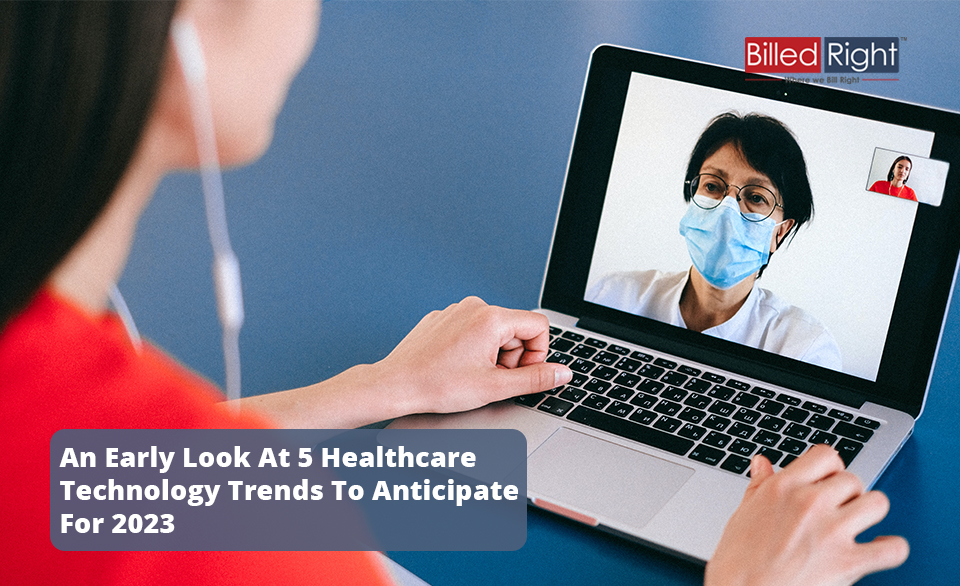A Look At 5 Healthcare Technology Trends To Anticipate For 2023

The healthcare industry has been traditionally much slower than other industries at adopting the newest digital technologies. Amid the coronavirus pandemic, the healthcare industry has been moving into a more collaborative, personalized and value-based model that takes patient preference as the main focus.
According to a March 24 McKinsey report, the consultancy rounded up 10 trends that are shaping the future of healthcare using research as well as expert testimony.
Tech Wearables will continue to revolutionize Healthcare
With demand for tech wearables such as FitBits and Apple Watches increasing year by year, Integration between mainstream technology wearables and healthcare systems does not seem out of the realm of possibilities. Use of health wearable technologies has more than tripled in the last four years and according to research from Insider Intelligence, more than 80% of U.S. consumers are willing to wear fitness technology.
The future of medical wearables seems very bright as the accessibility for tech wearable devices increases. This upward trend in wearable fitness technology will allow insurers and health providers to take advantage of the benefits the devices provide. The health data that these devices collect from patients will allow health providers to continuously record medical data at a low cost.
Recording medical data in combination with artificial intelligence will allow an opportunity to analyze the constant flow of data in order to track abnormal changes in a patient’s health. Artificial intelligence could detect abnormal heartbeat, respiration, or other signs that would indicate one’s worsening health.Catching abnormal changes before they worsen will be the key to improving health outcomes and lowering healthcare costs.
Remote Patient Monitoring
According to a report from MarketsAndMarkets, the global market for remote patient monitoring market is projected to reach USD 175.2 Billion by 2027 from USD 53.6 Billion in 2022. This growth in the market is both due to the decreasing cost and increased accessibility of medical wearable devices. Remote Patient Monitoring is a subset of telehealth that involves reporting and collection of a patient’s health data and thus the evaluation of a patient’s health.
Remote Patient Monitoring gained most of its popularity through the Covid-19 pandemic amid lockdowns. However, the pandemic has steered RPM as an effective way to deliver care to patients.
Practices that offer RPM services can:
- Increase availability of healthcare
- Reduce unnecessary in-office flow of patients
- Proactively manage the conditions of patients with chronic conditions
- Save remote patients extensive amounts of money and time
In combination with telehealth, Remote Patient Monitoring has the potential to both increase accessibility to healthcare, and reduce costs for patients. We are also not far from integration between AI, machine learning, and RPM to automate repetitive tasks in order to give physicians more time with their patients.
Read more about Patient Monitoring Here
Artificial Intelligence Transforming The Future Of Healthcare
Artificial intelligence has been playing a critical role in industries for decades. Only recently, however, has AI begun to take a leading role in healthcare on a mass scale.
One medical field where AI will soon be used in order to revolutionize care is in Radiology. Radiologists will soon be able to identify abnormalities in x-rays almost instantaneously by using artificial intelligence, which saves time and allows patients to get treated quicker. This increased accuracy also allows doctors and healthcare specialists to better understand a patient’s condition.
By 2030, artificial intelligence and the analysis of large data sets will help us understand more about the factors in our lives that will influence our health. These factors include not only when we might get the flu or what diseases we might inherit, but also aspects of our physical environment, such as our exposure to local air pollution levels or the safety of our housing. Some of these factors are called “social determinants of health” by the World Health Organization (WHO).
Healthcare systems can even anticipate when a person is at risk of developing a chronic disease and suggest preventive measures before the problem gets worse. This development has been so successful that rates of diseases strongly influenced by social determinants, such as diabetes, heart disease, and lung disease, are finally on the decline.
5G In Healthcare
Recent 5G connection technology will soon have the potential to improve and transform the way healthcare data is shared all over the world. 5G is capable of reaching speeds approximately 100 times faster than 4G connections. Although widespread implementation of 5G infrastructure is still a ways off, investments to create software in preparation of a worldwide 5G infrastructure.
5G’s ability to provide real-time remote control for robotic surgery, and to transfer large patient files rapidly, could prove valuable in many areas of healthcare, including telehealth and remote surgery. 5G will also allow patients to move around a hospital without feeling tethered to wired communication devices. Wearable devices could relay real-time monitoring data to doctors or other medical professionals to keep a patient safe. And 5G will deliver continual treatment information and support to patients wherever they may be within a hospital or healthcare facility.
Individuals Increasing Their Focus In Leading A Healthier Life
Due to increased accessibility and lower cost in health wearables, it has become easier for patients to focus on their personalized health data.
This rise of wearable technology allows patients to monitor their health with ease and precision, allowing them to be more diligent about their health and having them interact with physicians more than before. This increased focus between patient and physician will allow for clearer communication and integration of healthcare software to increase healthcare efficiency.
Recent strides in healthcare technology have made it much easier to care for their health and this in turn has continued a trend of individuals increasing their focus in leading a healthier life.






